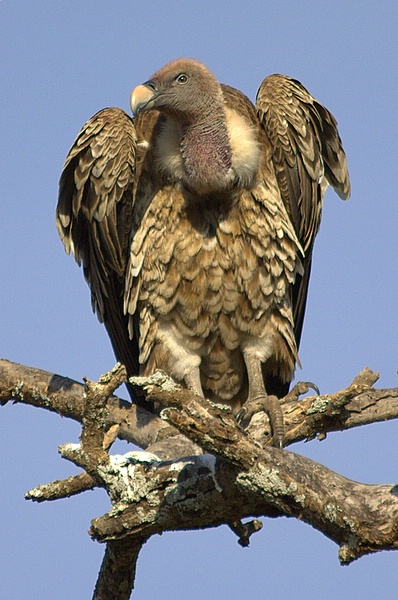- Rüppell's Vulture
Taxobox
name = Rüppell's Vulture

image_width = 200px
status = NT
status_system = iucn3.1
regnum =Animal ia
phylum =Chordata
classis =Aves
ordo =Falconiformes
familia =Accipitridae
genus = "Gyps "
species = "G. rueppellii"
binomial = "Gyps rueppellii"
binomial_authority = (A. Brehm, 1852)Rüppell's Vulture ("Gyps rueppellii") is a large
vulture that ranges across much of centralAfrica , includingEthiopia , theSudan ,Tanzania andGuinea . It is also known as Rüppell's Griffon, Rueppell's Vulture, Rüppell's Griffin Vulture, and similar variants, and is named in honor of the 19th century German explorer, collector and zoologistEduard Rüppell .Description
Adults are close to a metre (3 ft) in length, with a wingspan of around 2.6 m (8.6 ft), and a weight that usually ranges between 7 and 9 kg (15–20 lb). Both sexes are alike: mottled brown or black overall with a whitish-brown underbelly and thin, dirty-white fluff covering the head and neck. The base of the neck has a white collar, the eye is yellow or amber, the crop patch deep chocolate brown. Silent as a rule, they become vocal at the nest and when at a carcass, squealing a great deal.
Ecology
Rüppell's Vultures are highly social, roosting, nesting, and gathering to feed in large flocks. They can travel fast at need, cruising at up to 35 km/h, and will fly as far as 150 km from a nest site to find food. They can reach great heights, 6,000 m (20,000 ft) is not uncommon, and on one exceptional occasion, an aircraft over the
Côte d'Ivoire collided with a Rüppell's Vulture at the astonishing altitude of 11,300 m (37,000 ft), the current record avian height. [Thomas Alerstam, David A. Christie, Astrid Ulfstrand. Bird Migration (1990). Page 276. http://books.google.ca/books?id=OQjsL97yyhEC&pg=PA276&lpg=PA276&dq=ruppell%27s+vulture+airplane&source=web&ots=uZJ0vFfetl&sig=snETbB76wVqWIv6CJLM1QN90RkY&hl=en&sa=X&oi=book_result&resnum=5&ct=result#PPA276,M1] They have a specialized variant of thehemoglobin alphaD subunit; this protein has a high affinity for oxygen, which allows the species to take up oxygen efficiently despite the lowpartial pressure in the uppertroposphere . [cite journal |last= |first=
authorlink=
author=Weber R.E.
coauthors= Hiebl I., Braunitzer G.
year=1988 |month=April
title=High altitude and hemoglobin function in the vultures Gyps rueppellii and Aegypius monachus
journal=Biol Chem Hoppe Seyler |volume= 369
issue= 4
pages= 233–40
id= |url=http://www.ncbi.nlm.nih.gov/sites/entrez?cmd=Retrieve&db=PubMed&list_uids=3401328&dopt=Citation |accessdaymonth= 28 August
accessyear = 2007
accessdate= |quote= ]They are creatures of the more
arid and mountainous areas of Africa: particularly semi-desert and the fringes of deserts. They roost on inaccessible rock ledges if these are available, or in trees, usually "Acacia ". Whenthermal updrafts start to develop enough lift, about two hours after sunrise, Rüppell's Vultures leave the roost and begin to patrol over the plains, using their exceptionally keen eyesight to find large animal carcasses, orcarnivore s which have made a kill. They will wait, several days if necessary, until a carnivore leaves a carcass. They have been known to take live prey on occasion, but this is rare.Rüppell's Vultures have several adaptations to their diet and are specialized feeders even among the Old World vultures of Africa. They have an especially powerful bill and, after the most attractive soft parts of a carcass have been consumed, they will continue with the hide, and even the bones, gorging themselves until they can barely fly. They have backward-facing splines on the tongue to help remove meat from bone.
tatus
Rarer than previously believed, Rüppell's Vulture is uplisted from a species of Least Concern to Near Threatened in the 2007
IUCN Red List . [BirdLife International (2007a. b).]Gallery
References
*|year=2004|id=49342|title=Gyps rueppellii|downloaded=11 May 2006
* (2007a): [http://www.birdlife.org/action/science/species/global_species_programme/whats_new.html 2006–2007 Red List status changes] . Retrieved 26 August 2007.
* (2007b): [http://www.birdlife.org/datazone/search/species_search.html?action=SpcHTMDetails.asp&sid=3376&m=0 Rüppell's Vulture - BirdLife Species Factsheet] . Retrieved 26 August 2007.See also
* The
White-backed Vulture , which is slightly smaller and has a shorter neck.External links
* [http://ibc.hbw.com/ibc/phtml/especie.phtml?idEspecie=619 Rüppell's Vulture videos]
Wikimedia Foundation. 2010.
